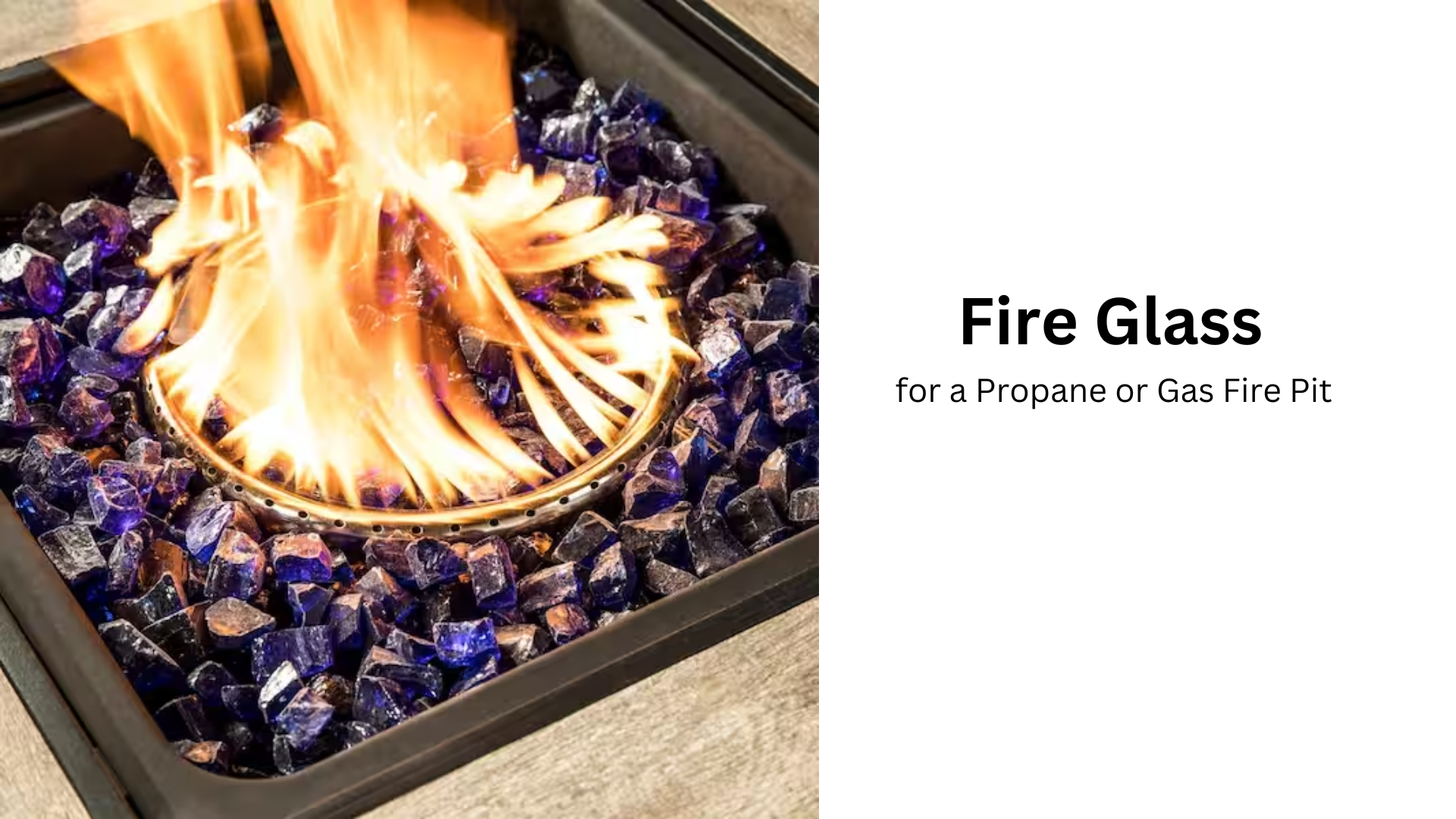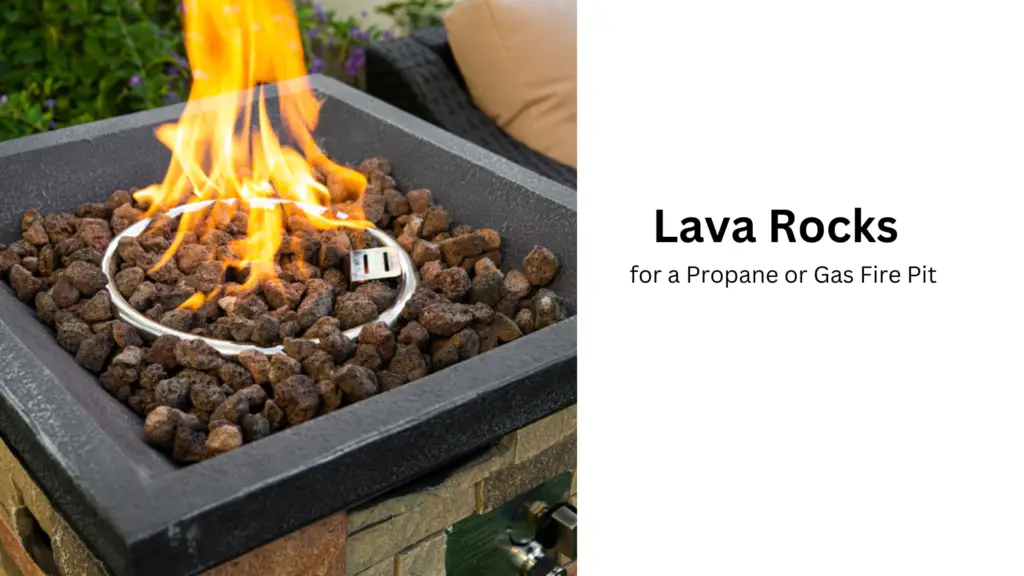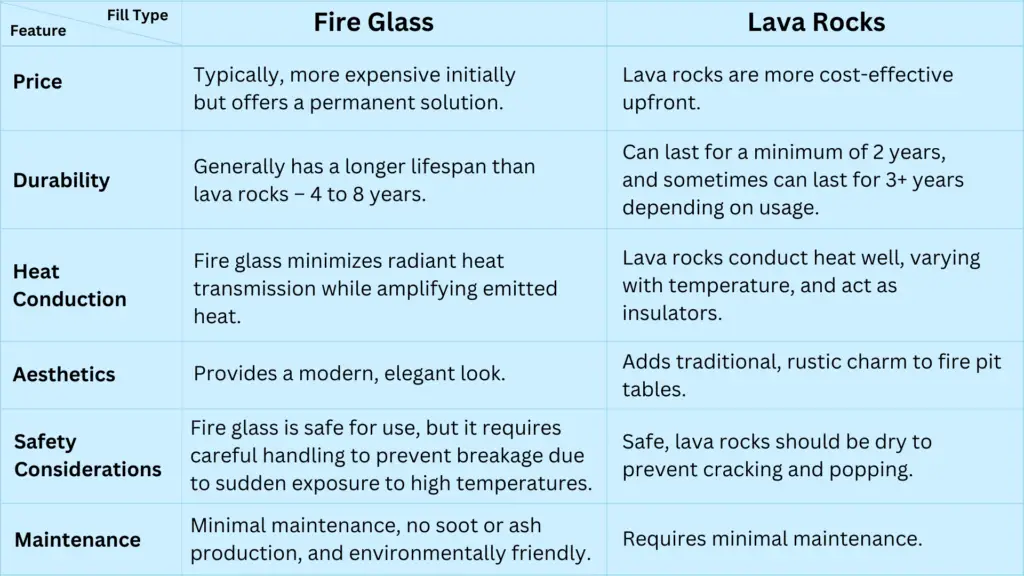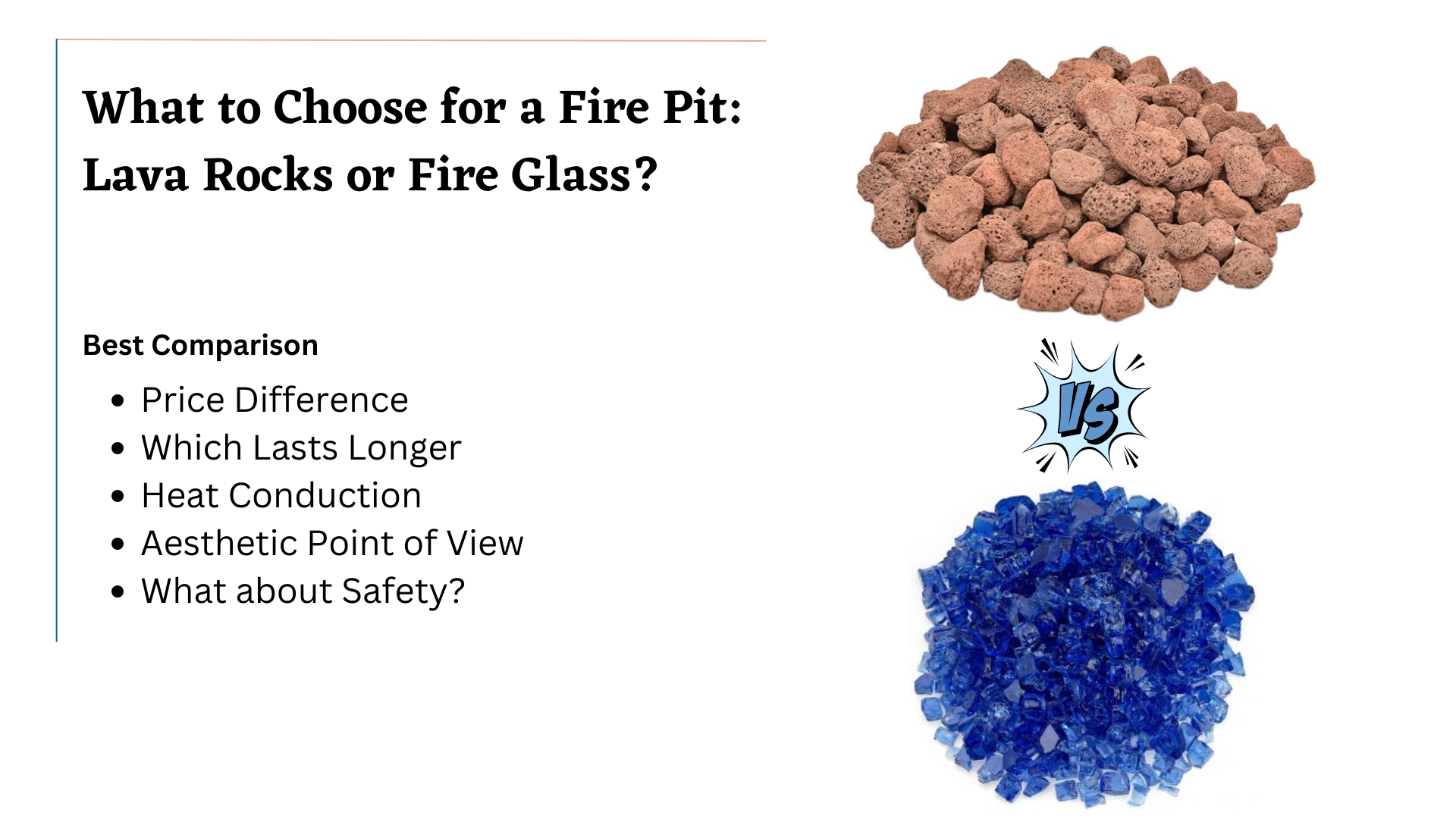Are you wondering whether lava rocks or fire glass is the better choice for your propane or gas fire pit table? This article is designed to help you navigate through the key aspects of these two popular materials.
To answer the question: What is better for a fire pit: lava rocks or fire glass? We compared their heat conduction capabilities, aesthetic appeal, maintenance requirements, cost implications, and safety considerations.
By the end of this guide, you’ll be equipped with all the necessary information to make an informed decision for your fireplace.
Quick Links
Let’s begin this journey to find the perfect fit for your fire pit!
What Is Fire Glass

Fire glass is tempered glass used in fire pits and gas fireplaces to enhance aesthetics and efficiency. Unlike traditional ceramic logs or lava rock, fire glass comes in small, pebble-like pieces that can withstand high temperatures without melting, burning or discoloring.
Tempered fire glass comes in various types, each bringing its unique flair to your outdoor space. Let’s explore these types:
- Classic: These are your quintessential fire glass pieces with a jagged, crystal-like appearance. They come in two sizes, 1/4″ and 1/2″, and a rainbow of colors to match any design scheme. Perfect for those who love a timeless look.
- Reflective: This type takes the sparkle up a notch. It mirrors the light from your fire pit, creating a mesmerizing, reflective effect. Available in standard colors, it also comes in a “luster” finish for an extra polished look.
- Fire beads: For a more modern vibe, fire beads are the way to go. Their rounded shape offers a sleek, contemporary look. Like reflective fire glass, they also come in standard colors and a shiny “luster” finish.
- Recycled: Eco-conscious and stylish, this fire glass is refired through an environmentally friendly process. It’s available in both 1/2″ and 3/4″ sizes and a variety of vibrant hues.
- Zircon: Named for its resemblance to the zircon crystal, this type adds a touch of luxury. Its multifaceted shine and unique shape create a high-end atmosphere in your entertaining area.
In addition to these types, fire glass also varies in size. While fine, medium, and large sizes are available, the most popular sizes for residential outdoor fire pits are 1/4″ and 1/2″ diameters. Half-inch fire glass is often recommended by experts for its practicality and cost-effectiveness. One of the best things about fire glass is the ability to mix and match different sizes and types, allowing you to create a truly personalized and stunning fire pit display.
Available in a variety of colors and shapes, it adds a modern, decorative touch while serving a practical purpose: concealing the gas jets, reflecting the flames to create a dazzling display, and distributing heat more evenly.
Its maintenance is minimal because it produces no soot or ash. And because it’s made from recycled glass, it’s an environmentally responsible choice for fire features.
What Are Lava Rocks

Lava rock, an igneous rock formed from cooled magma, is a popular choice for fire pits due to its natural heat resistance and excellent heat dissipation properties. This porous rock is strong, and safe, and enhances the beauty of a fire pit, adding a traditional, rustic charm.
Typically affordable and durable, lava rock serves as a protective base layer over burners and as a filler under other decorative elements.
Lava rocks, known for their porosity, enhance airflow to your burner. This feature not only aids in distributing heat uniformly but also contributes to a richer, more vibrant flame. In the realm of gas or propane fire pits, lava rocks are available in a diverse array of types and sizes.
You can choose from a spectrum of colors, predominantly red and black, with options for either a natural, rugged appearance or a tumbled, more polished look. The sizes vary widely, starting from the petite (?” to ?” in diameter), spanning to medium (?” to ?”), and extending up to the significantly larger XXLarge (4″ to 6″). This size range offers flexibility in design and function, accommodating various fire pit dimensions.
Additionally, the color palette of these rocks can vary from lighter shades of brown to deeper hues of black, allowing for further customization to match your outdoor decor aesthetic.
What Is Better for a Fire Pit Table – 5 Things to Consider
When it comes to choosing between fire glass and lava rock for your fire pit table, there are several factors to consider. Here are five things to keep in mind.
1. Price Difference
When evaluating the expense of fire glass vs. lava rock for fire pits, both the initial outlay and the potential for enduring use should be weighed. The second ones are typically more wallet-friendly at the outset.
Fire glass and lava rocks pricing
For instance, a 10-pound sack of tempered glass might be tagged at $25 to $35, and unique textures or hues could add to the price. On the flip side, volcanic rocks are usually offered by volume, with a cubic foot possibly priced near $20, or a 50-pound container estimated at $30. Despite the steeper initial investment, fire beads offer a robust, permanent solution that sidesteps the need for regular renewal.
Volcanic stones, though cost-effective, are prone to wear over periods of extensive use and might require topping up every couple of years. Coverage also plays a role; the denser makeup of tempered glass means more is required by weight to fill the same space as volcanic, potentially elevating the total expense.
Reflecting on the long-term, the permanence of fire glass might translate into better economic sense. Your selection between the two materials should factor in your financial plan, stylistic desires, and the regularity of your fire pit’s utilization.
2. Which Lasts Longer Fire Glass or Lava Rock
When weighing the durability of fire pit glass versus volcanic stone for fire pits, the former typically has a longer lifespan.
Fire glass lifespan
Fire pit glass, made from tempered glass shards, can withstand intense heat without melting, scorching, or changing its color, underscoring its resilience. It’s also impervious to soot buildup and can be refreshed with a simple wash after repeated use.
Lava rocks lifespan
Conversely, while volcanic stones have a robust composition, they may require more regular replacement. Over time, lava rock can fragment and wear away. If your fire pit sees regular activity, it may require volcanic replacement every two years. These stones also tend to produce some residue, which may require additional cleaning from time to time.
In terms of thermal efficiency, both fire pit glass and volcanic stone excel at conducting heat.
In summary, both fire pit glass and lava stones are durable materials that effectively transfer heat, but tempered beads have an edge in longevity due to their heat tolerance and color stability. Still, the choice between the two should be based on your aesthetic tastes and the frequency of your fire pit gatherings.
3. Heat Conduction of Lava Rock vs. Fire Glass
When comparing the heat conduction of lava rock and fire glass, it’s important to understand how each material interacts with heat.
Lava rocks heat conduction
Lava rock, a type of volcanic rock, has a thermal conductivity in the range of 0.001-0.002 W m(-1) K-1 at room temperature, which increases proportional to T-3 and reaches 0.040-0.060 W m(-1) at higher temperatures.
This means that lava rock can conduct heat, but its conductivity varies with temperature. Lava rock is also known to act as a poor conductor of heat and therefore, a good insulator, which explains how it regulates temperature.
Fireglass heat conduction
In contrast, fire beads, a specific category of heat-resistant glass, are fashioned to curtail the passage of intense radiant heat. This form of heat, composed of unseen, powerful electromagnetic waves, traverses swiftly with air posing minimal hindrance. Upon contact with a surface, these waves are absorbed, transforming their energetic charge directly into heat.
Fire beads not only shield against direct flame and smoke but also regulate heat transition through conduction, radiation, and convection mechanisms.
Filling a burner with such beads enhances its capacity to emit warmth up to fourfold compared to traditional wood or faux log setups, ensuring a steady and robust heat output.
In sum, lava rocks and fire glass both conduct heat, albeit through divergent mechanisms. Volcanic stone’s thermal conduction is temperature-dependent and it doubles as an effective insulator, whereas fire beads are engineered to minimize radiant heat transmission while amplifying emitted heat in a fire pit or fireplace setting.
4. Aesthetic Point of View
When it comes to visual appeal, both tempered glass and igneous stone offer unique charms that can enhance the aesthetics of your fire pit.
Fire glass aesthetics
Tempered glass has a smooth and refined surface that creates a radiant sheen. This handcrafted material is available in a variety of colors and contours, offering limitless possibilities to match any decorative style. The mirror-like quality of tempered glass catches the light, adding a touch of elegance and contemporary flair to your gathering space.
Lava rocks aesthetics
Conversely, igneous stone offers a raw, earthy look. Forged from the fiery depths of nature, these stones have a coarse texture that absorbs light, ensuring the fire’s glow remains undisturbed and centered. Often in subdued hues such as crimson, umber, or onyx, their muted tones harmonize with the blaze, positioning the vibrant flames as the focal point. For those who prefer a more classic or natural look, igneous stone is a top choice.
Mixing tempered glass and igneous stone in your fire pit is also an option, combining the benefits and visual appeal of each. Such a combination can create a distinctive and captivating aesthetic that blends the rugged beauty of igneous rock with the chic sophistication of tempered glass.
Whether you are drawn to the gleaming allure of tempered glass or the earthy charm of igneous rock, each choice can greatly enhance the appeal of your fire pit space.
5. What about Safety?
When choosing materials for fire pits, it’s important to know that both lava rocks and fire glass are safe to use. However, there are important safety tips to remember for each.
Lava rocks Safety
Lava rocks are very porous, which means they can soak up water. If they have water in them, and you heat them up, they can crack and pop, throwing pieces around. So, always make sure lava rocks are dry before you use them. Also, not all rocks are safe for fire pits. Rocks from rivers or your garden can explode when they get hot, so it’s best to use rocks that are meant for high heat.
Fire glass safety
Fire glass is made to handle high heat and is also safe for fire pits. It doesn’t hold water inside, so it’s less likely to crack. But if fire glass gets wet on the surface, it can still break from the sudden heat. When picking out fire glass, avoid pieces with sharp edges. These can be dangerous if someone touches them. Go for smoother-edged fire glass to keep things safe, especially if kids or pets are around.
In short, both lava rocks and fire glass are good for fire pits if you keep them dry and choose the right kind. Taking care of them and picking safe options will help you enjoy your fire pit without worry.
An Overview Table
I have created a summary table that compares the features of fire glass and lava rocks for your convenience. Please feel free to refer to it.

If you notice that I have overlooked any important criteria for comparison, please let me know by leaving a comment below this post.
In conclusion, the choice between fire glass and lava rocks is influenced by aesthetic preferences, heat retention, maintenance requirements, and cost considerations, making it a personal decision based on lifestyle?.
I trust that this table and the overall article have provided valuable insights. With this information, you should be well-equipped to make an informed choice regarding the best option for your propane or gas fire pit table.
Questions and Answers
Can I Mix Lava Rock and Glass in My Fire Pit?
Yes, you can mix lava rocks and fire glass in your fire pit. This combination can enhance aesthetic appeal while maintaining functionality. However, ensure proper placement to avoid obstructing gas flow.
Which Is Easier to Maintain?
Fire glass requires less maintenance as it is non-toxic, produces no ash or soot, and can be easily cleaned with dish detergent to remove any dust. Lava rocks, due to their porous nature, tend to collect debris and might need more frequent cleaning.
What Holds Heat Better: Lava Rocks vs. Fire Glass?
Both have unique heat retention properties. Lava rocks, being porous, disperse heat well. Fire glass, however, can radiate up to four times more heat than wood, making it highly efficient in heat radiation. Lava rocks excel in heat conduction, while fire glass is better at radiating heat.
What Are the Disadvantages of Fire Glass?
Fire glass is more expensive than lava rocks and requires careful handling to prevent the pieces from fusing. Although durable, it may need occasional cleaning to maintain its sparkling appearance.
What Are the Disadvantages of Lava Rocks?
While being a cost-effective, lightweight, and neutral-colored option, lava rocks may require more maintenance due to their porous nature. They don’t offer the same modern, colorful aesthetic as fire glass and may not hold heat as efficiently.
What Is Better: Fire Glass or Lava Rocks?
It’s quite hard to answer the question “What is better lava rocks or fire glass for a fire pit”. The decision between them depends on the desired aesthetic, heat retention, maintenance, and cost considerations, making it a matter of personal preference and lifestyle.
- Lava Rocks Vs. Fire Glass – What Is Better for a Fire Pit? - November 15, 2023
- How to Light a Propane/Gas Fire Pit with a Manual or Electronic Ignition System - November 8, 2023
- How Long Does a Propane Tank Last for a Fire Pit - October 9, 2023

